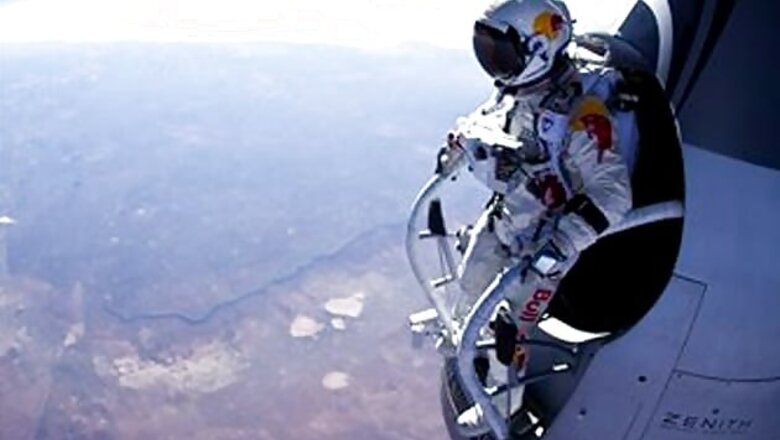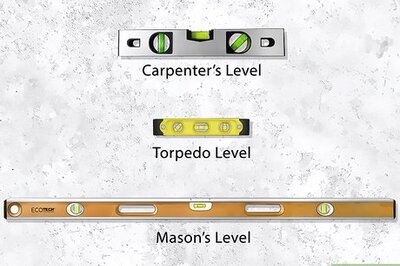
views
Roswell: Extreme athlete and skydiver Felix Baumgartner cancelled his planned death-defying 23-mile (37 kilometer) free fall on Tuesday into the New Mexico desert because of high winds. The 43-year-old former military parachutist from Austria had hoped to become the first skydiver to break the sound barrier and shatter three other world records.
But the weather forced his team to cancel his planned ascent in a 55-story, ultra-thin helium balloon that was to take him to the stratosphere. Because the balloon is so delicate, it could only take flight if winds were 2 mph (3.2 kph) or below.
Those plans were in question before sunrise, when winds at 700 feet (213 meters) above ground — the top of the balloon — were 20 mph (32 kph), far above the 3 mph (4.8 kph) maximum for a safe launch, mission meteorologist Don Day said.
With winds calming, they began the launch process, with Baumgartner suiting up and entering the capsule. During the inflation, a live online feed showed winds whipping the balloon around.
The balloon had been scheduled to launch about 7 a.m. from a field near the airport in a flat dusty town that until now has been best known for a rumored 1947 UFO landing.
Baumgartner was to make a nearly three-hour ascent to 120,000 feet (36,576 meters), then take a bunny-style hop from a pressurized capsule into a near-vacuum where there is barely any oxygen to begin what is expected to be the fastest, farthest free fall from the highest-ever manned balloon.
Baumgartner spent Monday at his hotel, mentally preparing for the dangerous feat with his parents, girlfriend and a few close friends, his team said. He had a light dinner of salmon and a salad, then had a massage. He spent Tuesday morning resting in an Airstream trailer near the launch site.
Among the risks: Any contact with the capsule on his exit could have torn the pressurized suit. A rip could have exposed him to a lack of oxygen and temperatures as low as 70 degrees below zero. It could have caused potentially lethal bubbles to form in his bodily fluids, a condition known as "boiling blood."
He could also have spin out of control, causing other risky problems.
The energy drink maker Red Bull, which is sponsoring the feat, has been promoting a live Internet stream of the event at http://www.redbullstratos.com/live from nearly 30 cameras on the capsule, the ground and a helicopter. But organizers said there will be a 20-second delay in their broadcast of footage in case of a tragic accident.
And while Baumgartner hopes to set four new world records when he jumps, his free fall is more than just a stunt. His dive from the stratosphere should provide scientists with valuable information for next-generation spacesuits and techniques that could help astronauts survive accidents.
Jumping from more than three times the height of the average cruising altitude for jetliners, Baumgartner expects to hit a speed of 690 mph (1,110 kph) or more before he activates his parachute at 9,500 feet (2,895 meters) above sea level, or about 5,000 feet (1,524 meters) above the ground in southeastern New Mexico. The total jump should take about 10 minutes.
His medical director is Dr. Jonathan Clark, a NASA space shuttle crew surgeon who lost his wife, Laurel Clark, in the 2003 Columbia accident. No one knows what happens to a body when it breaks the sound barrier, Clark said.
"That is really the scientific essence of this mission," said Clark, who is dedicated to improving astronauts' chances of survival in a high-altitude disaster.
Clark told reporters Monday he expects Baumgartner's pressurized spacesuit to protect him from the shock waves of breaking the sound barrier. If all goes well and he survives the jump, NASA could certify a new generation of spacesuits for protecting astronauts and provide an escape option from spacecraft at 120,000 feet (36,576 meters), he said.
Currently, spacesuits are certified to protect astronauts to 100,000 feet (30,480 meters), the level former Air Force Capt. Joe Kittinger reached in his 1960 free-fall record from 19.5 miles (31 kilometers). Kittinger's speed of 614 mph (988 kph) was just shy of breaking the sound barrier at that altitude.




















Comments
0 comment